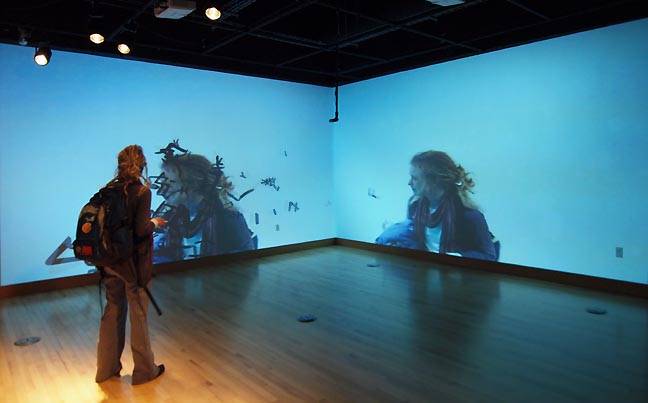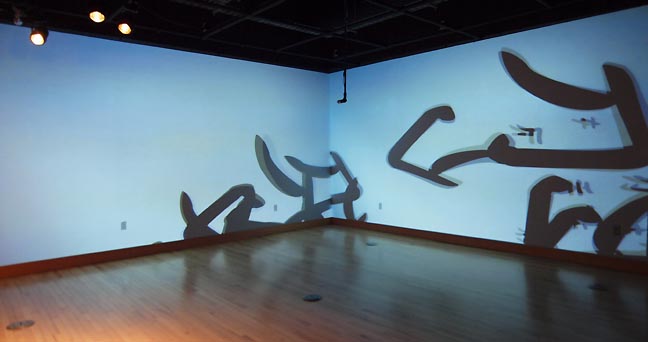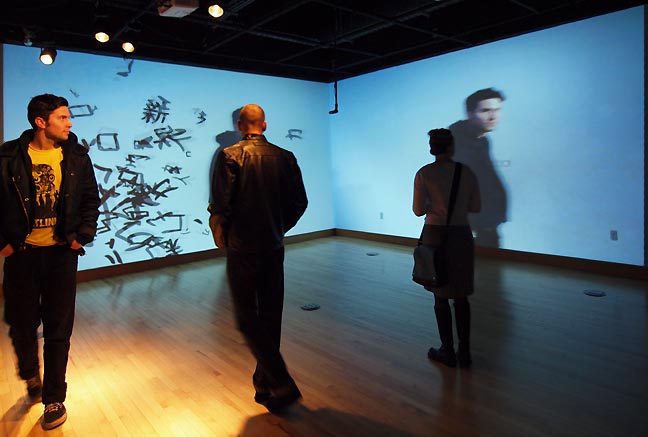Hung Keung's Bloated City | Skinny Language 
Hung Keung's Bloated City | Skinny Language at the the U of O's White Box is easily the most engaging exhibition this month in Portland. It's an interactive affair where viewers are greeted by floating Chinese characters that seem to drift and sway in a haphazardly poetic wind until the viewer steps into certain sections of the gallery and suddenly the characters swarm the projected image of the viewer like flies. Eventually the giant letters for the word knife cut across the screen and end this alternate universe/doppelganger experience.
So what's it all about? First off, let's discuss the written Chinese Language. For the Chinese, ideas and images are not separate disciplines. Notoriously complex, the language is a masterpiece of poetic elegance utilizing logograms (pictograms, ideagrams or phonetigrams).

(all photos Jeff Jahn)
Considering its complexity in these times of rapid change it is natural for the Chinese to be both proud and sometimes suspicious of their language. As the song goes:
Poets, priests, and politicians
Have words to thank for their positions
Words that scream for your submission
No-one's jamming their transmission
And when their eloquence escapes you
Their logic ties you up and rapes you
-The Police: De Do Do Do, De Da Da Da
Still the calligraphic aspect alone is impressive, especially when used as Heung has done here. Then again Chinese is inherently beautiful and one of my favorite examples of its allegorical content is the pictogram for domestic happiness, which shows a man and a woman in a house. Similarly its antipode "household strife" is a man and two women in one house. With thousands of logograms the full language allows readers the ability to read texts thousands of years old. For comparison, reading Olde English, Elizabethan English of Shakespeare or even Latin is simply not possible without specialized instruction. Conversely, until recently this backwards compatible standardization was the standard for educated Chinese making their very distant past very accessible. Recently, to streamline the language a simplified Chinese has taken form. This is where the "skinny language" comes into the exhibition and many of Hung's fellow countryman now only know simplified Chinese, despite being well educated. True it is streamlined for practical purposes but a tremendous cultural richness is lost in the rush to modernize the language. In fact, the piece was commissioned for the inauguration of The Zhongguancun district (Beijing's silicon valley district), which displaced a huge number of ancestral villages. This sprawl is the "bloated city" and the recurring word knife" signifies the cut that such changes in language and settlement apparent with such developments.
Currently the art world is painfully aware of the constant surveillance of Chinese citizens (Ai Weiwei's arrest as an extreme but chilling example) but in many ways this is endemic of a highly social society going far back. Even in the influential but short lived Qin Dynasty such practices were routine.
Here, what Hung Keung does with his piece is point out the way the divergent streams of history mix in contemporary Chinese society by transporting the viewer through the looking glass into a place where language and surveillance is incredibly rich, practical and yet parasitic or even oppressive. Yes it is spectacle art, but that spectacle is also a kind of freedom to criticize and explore... the sort that is absolutely crucial for any contemporary society or art scene. Think of contemporary art as the canary in a modern civilization's coal mine.

Yes, perhaps better than any human civilization the Chinese know that language is power and they exercise it. I found Hung Keung's Bloated City | Skinny Language moving as it allows both the oppressive and freeing power of language and image to co-exist as a form of essential poetic critique. Think of it as an exercise in civic/individual equilibrium and it's themes of privacy and communication have analogs in any modern society. Thankfully this translation and transfiguration of modern China can be transported and shared in far away places like Portland Oregon where the worst sanction a contemporary artist faces is merely a bad review.
Through May 14th
via PORT by Jeff Jahn on 4/13/11

Hung Keung's Bloated City | Skinny Language at the the U of O's White Box is easily the most engaging exhibition this month in Portland. It's an interactive affair where viewers are greeted by floating Chinese characters that seem to drift and sway in a haphazardly poetic wind until the viewer steps into certain sections of the gallery and suddenly the characters swarm the projected image of the viewer like flies. Eventually the giant letters for the word knife cut across the screen and end this alternate universe/doppelganger experience.
So what's it all about? First off, let's discuss the written Chinese Language. For the Chinese, ideas and images are not separate disciplines. Notoriously complex, the language is a masterpiece of poetic elegance utilizing logograms (pictograms, ideagrams or phonetigrams).

(all photos Jeff Jahn)
Considering its complexity in these times of rapid change it is natural for the Chinese to be both proud and sometimes suspicious of their language. As the song goes:
Poets, priests, and politicians
Have words to thank for their positions
Words that scream for your submission
No-one's jamming their transmission
And when their eloquence escapes you
Their logic ties you up and rapes you
-The Police: De Do Do Do, De Da Da Da
Still the calligraphic aspect alone is impressive, especially when used as Heung has done here. Then again Chinese is inherently beautiful and one of my favorite examples of its allegorical content is the pictogram for domestic happiness, which shows a man and a woman in a house. Similarly its antipode "household strife" is a man and two women in one house. With thousands of logograms the full language allows readers the ability to read texts thousands of years old. For comparison, reading Olde English, Elizabethan English of Shakespeare or even Latin is simply not possible without specialized instruction. Conversely, until recently this backwards compatible standardization was the standard for educated Chinese making their very distant past very accessible. Recently, to streamline the language a simplified Chinese has taken form. This is where the "skinny language" comes into the exhibition and many of Hung's fellow countryman now only know simplified Chinese, despite being well educated. True it is streamlined for practical purposes but a tremendous cultural richness is lost in the rush to modernize the language. In fact, the piece was commissioned for the inauguration of The Zhongguancun district (Beijing's silicon valley district), which displaced a huge number of ancestral villages. This sprawl is the "bloated city" and the recurring word knife" signifies the cut that such changes in language and settlement apparent with such developments.
Currently the art world is painfully aware of the constant surveillance of Chinese citizens (Ai Weiwei's arrest as an extreme but chilling example) but in many ways this is endemic of a highly social society going far back. Even in the influential but short lived Qin Dynasty such practices were routine.
Here, what Hung Keung does with his piece is point out the way the divergent streams of history mix in contemporary Chinese society by transporting the viewer through the looking glass into a place where language and surveillance is incredibly rich, practical and yet parasitic or even oppressive. Yes it is spectacle art, but that spectacle is also a kind of freedom to criticize and explore... the sort that is absolutely crucial for any contemporary society or art scene. Think of contemporary art as the canary in a modern civilization's coal mine.

Yes, perhaps better than any human civilization the Chinese know that language is power and they exercise it. I found Hung Keung's Bloated City | Skinny Language moving as it allows both the oppressive and freeing power of language and image to co-exist as a form of essential poetic critique. Think of it as an exercise in civic/individual equilibrium and it's themes of privacy and communication have analogs in any modern society. Thankfully this translation and transfiguration of modern China can be transported and shared in far away places like Portland Oregon where the worst sanction a contemporary artist faces is merely a bad review.
Through May 14th
No comments:
Post a Comment